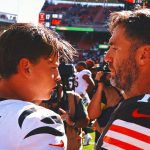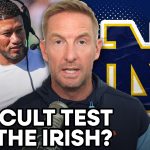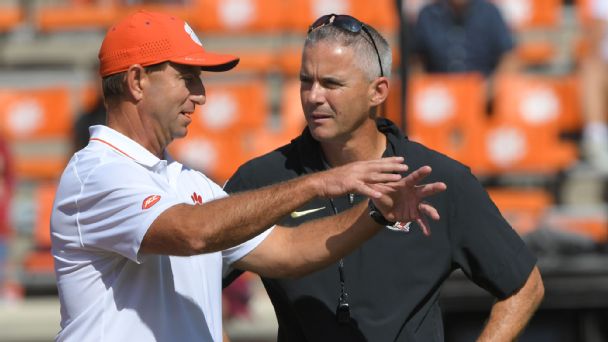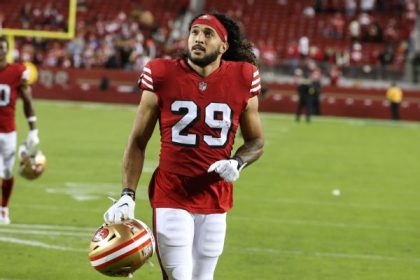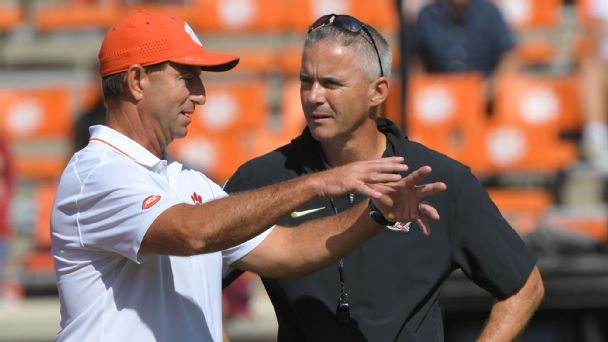
Welcome to the 2024 college football season, where the playoff is bigger, the (remaining) power conferences are, too, Nick Saban is working for ESPN and just about everybody needs new receivers (and maybe defensive backs and defensive linemen, as well).
After a couple of years of epic change off the field, we’ll see some of the fruits of that change on the field this fall, but the early list of national title favorites looks awfully familiar. Georgia leads the way, according to both the metrics and ESPN BET, with Ohio State, Oregon, and last year’s semifinalists — Texas and Alabama — among the Dawgs’ chief competitors. What stands in the way of these teams and the ultimate prize? What questions will they need to answer between now and January?
According to SportsOddsHistory.com, no national champion over the past 23 seasons has begun the season with title odds worse than +5000. Could the College Football Playoff’s expansion to 12 teams alter that trend? Perhaps. But while upsets could bust brackets, the best teams are still the most likely to win three to four games and take the title. So let’s stick with the +5000 barrier: Here are the 16 teams that meet those standards per ESPN BET. They are sorted by the number of “ifs” that need to break their way to make them champs. (As always, we’re not going to worry about obstacles like injuries to stars, which could strike any team at any time. Those concerns are obvious and universal.)
Jump to an ‘if’ tier:
2 | 3 | 4 | 5

Two ifs
![]()
If … new playmakers emerge. There are plenty of reasons Kirby Smart’s Dawgs start out atop the field. They’re 42-2 over the past three seasons. Even with last year’s untimely loss to Alabama costing them a spot in the CFP, they were almost certainly the second-best team in the country at absolute worst. And unlike five of the top nine title favorites, they return their starting quarterback (Carson Beck), along with four offensive line starters and 10 of the 17 defenders with 200-plus snaps.
There’s turnover in the skill corps, however. Last year’s two leading rushers and three of five leading receivers, including all-world tight end Brock Bowers, are gone, and while there are former blue-chippers everywhere you look, it’s still going to be a pretty new unit. Florida transfer Trevor Etienne will join sophomores Branson Robinson and Roderick Robinson II in the backfield. The receiving corps will be a combination of known veterans — slot man Dominic Lovett, junior Dillon Bell, senior Rara Thomas, tight end Oscar Delp — and newbies such as transfers Colbie Young (Miami), London Humphreys (Vanderbilt) and tight end Benjamin Yurosek (Stanford). Some of the requisite incoming freshman blue-chippers could break through, too. The candidates list is immense, but there are some absolute stars to replace.
If … the Dawgs are road warriors. It’s rare that you see a top-five team taking on a top-five schedule. Georgia’s schedule ranks fifth overall in difficulty, featuring the teams currently projected fourth (Texas), fifth (Alabama), eighth (Ole Miss), 14th (Clemson), 16th (Tennessee) and 25th (Kentucky) in SP+. Incredibly, only Tennessee visits Athens. Georgia will play Clemson in Atlanta and the other four are on the road. You get a couple of mulligans now with the expanded 12-team playoff, but even an elite team might go 10-2 or 9-3 against this schedule. Tread carefully, Dawgs.
![]()
If … Will Howard is actually an upgrade. Let’s play a game of QB A vs. QB B!
-
QB A: 66% completion rate, 13.8 yards per completion, 4.4% sack rate, 1.7% INT rate, 45 non-sack rushing yards, 83.8 Total QBR (seventh)
-
QB B: 61% completion rate, 12.1 yards per completion, 4.3% sack rate, 2.8% INT rate, 455 non-sack rushing yards, 75.1 Total QBR (23rd)
QB B is clearly the better rusher, though he did most of his damage on designed runs that might not be a feature of his new offense. QB A completed more of his passes to his team and fewer to the other team.
QB A is Kyle McCord, the dethroned Ohio State starter who transferred to Syracuse. QB B is Will Howard, thought to be an obvious upgrade. Now, McCord had Marvin Harrison Jr., Emeka Egbuka, Cade Stover & Co. at his disposal; this is not to say that he was clearly the better quarterback. But we won’t know that Howard is actually better until he shows it. And if he doesn’t, Ohio State probably won’t win the national title.
If … blue-chip receivers play like blue-chippers. The Ohio State defense might be the single-most proven unit in the country and new offensive coordinator Chip Kelly will have lots of fun with a backfield of TreVeyon Henderson, Ole Miss transfer Quinshon Judkins and an experienced O-line. Outside of QB, however, Ohio State really only has one question mark, and it’s one with lots of potential answers: receiver. Egbuka is the only impact returnee, and while there are countless recent blue-chippers in the pipeline — such as freshman Jeremiah Smith, sophomores Carnell Tate and Brandon Inniss — a few of them will have to play like upperclassmen in 2024.
Three ifs
![]()
If … Dillon Gabriel indeed fits like a glove. It’s easy to make assumptions about Dillon Gabriel. The dude has 14,865 career passing yards and 151 combined passing and rushing TDs. He’s been a star for a while, and he was incredible at Oklahoma last year. He finished third in Total QBR, and coordinator Will Stein’s Oregon system sure seems like a perfect fit. But Bo Nix was second in Total QBR and combined an otherworldly 77% completion rate with an equally ridiculous 45-3 ratio of touchdowns to interceptions. Oregon finished the season third in SP+ and returns loads of star power, but any downgrade at QB would be costly. Gabriel has to clear a ridiculously high bar.
If … the remodeled defensive line holds up. The Ducks surged from 74th to 16th in defensive SP+ last season and return stars such as end Jordan Burch and nickel Tysheem Johnson. But Burch is the only one of last year’s top six linemen to return, and there’s going to be a lot of pressure on both transfers such as Derrick Harmon (Michigan State) and Jamaree Caldwell (Houston) and blue-chip youngsters such as sophomore Matayo Uiagalelei and freshman Aydin Breland to play at a really high level. Recruiting has stocked the two-deep with potential, but some new stars must emerge.
If … the remodeled secondary does too. With corners Jabbar Muhammad (Washington) and Kam Alexander (UTSA), nickel Brandon Johnson (Duke) and safety Kobe Savage (K-State), Dan Lanning has added four DBs who combined for 18 TFLs, 8 INTs and 33 pass breakups at their previous schools. The potential in the secondary is massive, but with only one of last year’s top four DBs returning, this is also going to be a totally new unit. Can it jell in time for some of the season’s bigger tests?
![]() If … Quinn Ewers builds a rapport with lots of new receivers. After throwing for 3,479 yards and leading Texas to its best season in 14 years, Ewers returned for his junior season. He has proven running backs and an immensely big and experienced O-line in front of him. He also has a brand new set of receivers.
If … Quinn Ewers builds a rapport with lots of new receivers. After throwing for 3,479 yards and leading Texas to its best season in 14 years, Ewers returned for his junior season. He has proven running backs and an immensely big and experienced O-line in front of him. He also has a brand new set of receivers.
Last year’s top five targets are all gone, and while Steve Sarkisian has landed plenty of blue-chip youngsters of late (sophomore Johntay Cook II could be ready for a leap), Ewers will be leaning heavily on a quartet of transfers. Silas Bolden (Oregon State) and Isaiah Bond (Alabama) were particularly big gets. The talent in this unit is obvious, but we’ll find out how much familiarity and rapport matter.
If … the new beef is as good as the old beef up front. The defensive line also needed some retooling following the loss of two excellent tackles, Outland winner T’Vondre Sweat and Byron Murphy II. Seniors Alfred Collins and Vernon Broughton will still provide experience and size, but Sarkisian brought in a trio of tackle transfers: two 320-pounders (Louisville’s Jermayne Lole and Arizona’s Bill Norton) and a lighter disruptor (Arizona’s Tiaoalii Savea). Throw in former UTSA star defensive end Trey Moore, and you’ve got a talented but awfully new defensive front.
If … the Horns can cover. Texas didn’t blitz a ton last season, which made it a bit confusing when they also didn’t contest many passes (25.2%, 103rd in FBS) and gave up a ton of big gains (46 passes of 20-plus yards, 108th). With a pair of frequently used corners departing, Sarkisian is hoping that transfers Jay’Vion Cole (San Jose State) and Andrew Mukuba (Clemson) both click alongside slot corner Jahdae Barron and excellent sophomore Malik Muhammad.
Four ifs
![]()
If … the new skill corps makes plays. Seriously, it’s like everyone has a new skill corps! Quarterback Jalen Milroe is there, but Kalen DeBoer’s first Crimson Tide team returns only one player who gained 300 yards either rushing or receiving. DeBoer brought slot man Germie Bernard and Josh Cuevas with him from Washington, junior receiver Kobe Prentice is a keeper, and hey, this is still Alabama, with all its requisite blue-chippers. But how long will it take for new stars to emerge?
If … there’s a pass rush. Alabama had three players record more than three sacks last season, and they’re all gone. Tackle Jah-Marien Latham and linebackers Jihaad Campbell and Quandarrius Robinson produced stellar pressure rates that suggest they could turn into strong pass rushers, and again, there are lots of recent blue-chippers on the roster. But the pass rush is starting over.
If … a brand new secondary isn’t a liability. The secondary is really starting over. Returning nickelback Malachi Moore is outstanding, but of the 14 DBs who saw the field at some point last year, Moore is one of only two returning. DeBoer brought in five defensive backs from the portal, including corner DaShawn Jones (Wake Forest) and safety Keon Sabb (Michigan), but if they don’t immediately click, coordinator Kane Wommack will have to lean heavily on freshmen.
If … the noise isn’t overwhelming. “Coach Saban did that this way.” “Coach Saban didn’t do it like that.” “Coach Saban, Coach Saban, Coach Saban.” DeBoer has been good at every football job he has ever had. He’s an incredible coach. But the noise that comes with replacing a legend can be deafening, especially after the first loss or two. It’s something you can’t really prepare for ahead of time.
![]()
If … Garrett Nussmeier has a skill corps. Granted, it’s not succeeding Nick Saban, but succeeding Heisman winner Jayden Daniels will still be tricky. Nussmeier did his best to alleviate concerns with an excellent bowl performance, but the receiving corps lost first-round receivers Malik Nabers and Brian Thomas Jr. Kyren Lacy is a potential star, Liberty transfer CJ Daniels was incredible in Conference USA, and LSU doesn’t usually struggle to produce big-time receivers. But the receivers are only semi-proven, and the running backs less proven.
If … Joe Sloan’s ready. When head coach Brian Kelly lost offensive coordinator Mike Denbrock to Notre Dame, he justifiably promoted Sloan, last year’s QBs coach. If he’s as good at calling plays as he was at getting the most from Daniels, LSU’s offense will be fine.
If … Blake Baker figures out Harold Perkins Jr. Baker left his gig as Missouri’s defensive coordinator to become the best-paid assistant in the country. Baker’s defenses are aggressive, physical and fun, but he’s inheriting the pieces of a defense that ranked just 52nd in defensive SP+.
He’s also inheriting Perkins. Perkins was one of the most disruptive freshmen we’ve ever seen in 2022, but he was merely very good last year while playing less in an outside linebacker role, his most effective position. Baker has talked about playing Perkins on the inside, but he’ll need to get the most out of the junior one way or another.
If … the pass defense defends the pass. LSU ranked a dismal 107th in yards allowed per dropback last year. Most of last year’s secondary returns, and Kelly added Texas A&M safety Jardin Gilbert and Ohio State corner Jyaire Brown, among others, from the transfer portal. How long might it take for Baker to create something more effective from these ingredients?
![]()
If … the offensive line is as good as it looks on paper. “I think this is the first time Ole Miss can really match up, up front. It’s always been their issue. … They’re going to look more like an SEC team.” That’s what Nick Saban said about Ole Miss at SEC media days.
Ole Miss has averaged an 11.3 SP+ ranking over the past three seasons, going 29-10 (0-4 against Saban’s Alabama and Kirby Smart’s Georgia and 29-6 against everyone else). Lane Kiffin loaded up in the trenches through the portal, landing four big offensive linemen, including both guards from Washington’s 2023 line (Nate Kalepo and Julius Buelow). The Rebels are huge and experienced; has Kiffin closed the gap?
If … the defensive line is too. The Rebels return four of last year’s top six D-linemen, but Kiffin also added Florida pass rusher Princely Umanmielen and Texas A&M tackle Walter Nolen, the former No. 1 prospect in the country. This sure looks like the best D-line Kiffin has had. Again: Is it enough?
If … the portal also provided good cornerbacks. In addition to the key line transfers, Kiffin also loaded up on skill corps transfers, and perhaps most importantly, he added six DBs to fill in a depth chart that lost six of last year’s top eight. Nickelback Yam Banks (South Alabama) is strong and physical, but the corners — namely, Isaiah Hamilton (Houston) and Trey Amos (Alabama) — need to thrive quickly.
If … early wins create chemistry. The Rebels’ first four opponents are all projected 78th or worse in SP+, but things pick up from there with four top-25 opponents in six games. They visit LSU and welcome Oklahoma and Georgia to Oxford. This will be where the Playoff push is made or broken.
![]()
If … Riley Leonard is ready. After succeeding with Sam Hartman last season, Marcus Freeman imported another ACC QB: Duke’s Riley Leonard. When healthy, he’s both a safe, accurate passer and dynamic runner. But he suffered a nasty-looking ankle injury last season against the Irish, and he has had two ankle surgeries this offseason. The Irish have some decent young backup options if Leonard isn’t 100% effective, but they probably aren’t title contenders without him.
If … a third offensive coordinator thrives. Notre Dame jumped to 14th in offensive SP+ with first-year OC Gerad Parker, but he left for the Troy head coaching job. Now Mike Denbrock, Freeman’s third OC in three years, begins his second stint as Irish playcaller after helping to turn Jayden Daniels into a Heisman winner at LSU.
If … the O-line is a retooling job, not a rebuild. Since 2018, Notre Dame has had seven offensive linemen selected in the first three rounds of the draft, including three top-10 picks. We just assume the pipeline is always stocked. But the Irish lost two more top-60 picks in 2024, center Zeke Correll transferred, and the 10 spots on the two-deep could feature seven redshirt freshmen or sophomores.
If … the Irish win in Week 1. The Irish’s schedule is both a benefit and liability. On one hand, they play only four projected top-30 teams, and they’re rather evenly spaced out (Games 1, 5, 9 and 12). They don’t need to be in fifth gear or have a perfect QB situation every week. On the other hand, they rank only 51st in SP+ strength of schedule, meaning they might need to go 11-1 to feel totally safe in the CFP race. Losing in Week 1 at Texas A&M would eliminate most of their margin for error.
![]()
If … Andy Kotelnicki unlocks Drew Allar. A big-armed former five-star prospect, Allar was strangely conservative, almost to a fault, in his first season as PSU’s starter. He threw only two interceptions all season and took only 15 sacks, but he also averaged 10.6 or fewer yards per completion in eight of 13 games and averaged only 11.3 for the season. He threw only 8% of his passes 20 yards downfield or farther. (The national average: 14.3%. And most guys don’t have his arm strength.) Kotelnicki designed a crafty and explosive offense at Kansas, and if that translates with Allar and the Nittany Lions, they immediately have top-five upside.
If … Allar has receivers. Only three players caught more than 26 passes in 2023, and two are gone. Tight end Tyler Warren is solid, but for Allar to find his aggressive streak, a new set of wideouts — junior Harrison Wallace III, Ohio State transfer Julian Fleming, and blue-chip sophomores Kaden Saunders, Anthony Ivey and Mehki Flowers — need to do their part.
If … Allar also has protection. Also important! PSU was sixth in havoc rate allowed last season, and while some of that had to do with Allar’s aforementioned conservatism, it also stemmed from good line play. Will that continue with three starters, including consensus All-American left tackle Olu Fashanu, gone?
If … new cornerbacks do their job. There are fewer concerns for a defense that has finished seventh or better in defensive SP+ for three straight years (and five of seven). But corners Johnny Dixon and Kalen King were awfully good, and new coordinator Tom Allen will have to find some trustworthy pieces among transfers Jalen Kimber (Florida) and A.J. Harris (Georgia) and returnees Cam Miller, Zion Tracy and Elliot Washington II.
![]()
If … the anger has subsided. “With the excellent work Mike Norvell has done in rebuilding a broken FSU program over the past four years, odds are solid that he will craft another playoff-worthy team, one that the committee might deign to include even if the injury bug bites again. But that won’t change what it just did to the Seminoles.” That’s what I wrote after FSU was snubbed out of a CFP bid last year despite an unbeaten record. I still believe that, but the first step toward another CFP bid is moving forward. That sometimes takes a little while.
If … DJ Uiagalelei‘s return to the ACC is a happy one. Quarterback Jordan Travis set a high bar for Oregon State transfer DJ Uiagalelei to clear. Of course, Uiagalelei ranked 12th in Total QBR, two spots higher than Travis, in 2023. He’s not nearly the scrambler, but he takes fewer sacks and gets the ball downfield more. And now he’s got a shot at ACC redemption after leaving Clemson following a frustrating 2022 season.
If … Uiagalelei has receivers. Keon Coleman and Johnny Wilson combined for 91 catches, 1,275 yards and 13 touchdowns last season. They’re both gone, and only one returning wideout caught more than nine balls. Uiagalelei will have to lean on slot man Ja’Khi Douglas, Alabama transfer Malik Benson and a lot of youngsters.
If … the portal provided good defensive tackles. Of last year’s top seven linemen (in terms of snap counts), five are gone. Granted, one of the returnees, Patrick Payton, is one of the best defensive ends in the country, but four of the top five tackles are gone. Transfers Grady Kelly (Colorado State) and Tomiwa Durojaiye (West Virginia) will have to immediately log snaps in the middle.
![]()
If … new DTs are good DTs. Eliah Drinkwitz’s Tigers enter 2024 coming off their best season in a decade, they return stars such as receiver Luther Burden III and quarterback Brady Cook, and they’re facing the easiest schedule they’ll ever have in an expanded SEC. It’s a massive opportunity. Three of last year’s top four defensive tackles are gone, however, and some combination of senior Kristian Williams, transfers Chris McClellan (Florida) and Sterling Webb (NMSU) and youngsters must thrive.
If … the secondary still has pop. The defining characteristic of Mizzou’s defense was extreme physicality in the back, and while there are plenty of experienced DBs — nickelback Daylan Carnell and safety Joseph Charleston are strong — losing the nasty trio of corners Kris Abrams-Draine and Ennis Rakestraw Jr. and safety Jaylon Carlies could still impact that physical identity.
If … an upgraded O-line thrives. Mizzou’s offense leaped from 57th to 13th in offensive SP+ in 2023, but the line was still pretty average, ranking 106th in O-line penalties per game and 78th in total blown block rate. Drinkwitz went big in the portal, adding five-star sophomore guard Cayden Green (Oklahoma) and all-AAC tackle Marcus Bryant (SMU). Can they shift this line into a different gear?
If … the god of close games is kind again. Mizzou was lucky to survive last September unbeaten, winning three one-score games and needing Harrison Mevis’ heroic 61-yard buzzer-beating field goal to beat Kansas State. From there, the Tigers went from lucky to legit, beating three SP+ top-25 teams by double digits, surging from 34th to 10th and needing only one close win (again thanks to Mevis) from there. Teams rarely go 4-0 in one-score finishes for two straight years. Can the Tigers make a playoff run without Mevis and a benevolent close-games god?
![]()
If … Nico Iamaleava is ready. In some ways, Tennessee’s 35-0 Citrus Bowl blowout of Iowa felt like a statement of intent. A fierce Volunteers pass rush led in part by James Pearce Jr. wouldn’t let Iowa breathe, and in his first career start, five-star freshman QB Nico Iamaleava completed a solid 63% of his passes and executed the red zone offense with perfection.
Iamaleava also took six sacks and averaged a ho-hum 12.6 yards per completion. He still looked like a true freshman at times. The Vols are an intriguing CFP candidate, but only if he’s ready to turn upside and potential into production from the very start of the season.
If … the big pass plays return. Cannon-armed Joe Milton III averaged only 12.3 yards per completion last season as the big plays we’ve come to expect from a Josh Heupel offense subsided dramatically. Iamaleava needs to do a better job than Milton in keeping his eyes downfield, and among slot man Squirrel White, senior Bru McCoy, Tulane transfer Chris Brazzell II and other youngsters, his receivers need to take better advantage of their opportunities.
If … red zone issues subside. Red zone execution becomes more important when you aren’t making enough big plays, and Tennessee ranked a dreadful 104th in red zone touchdown rate. Iamaleava’s legs could come in handy here, but one way or another, improvement is a must.
If … a new (and thin?) secondary holds up. Tennessee’s defense was excellent against the run and, when the QB had time to throw, rather mediocre against the pass. Pearce & Co. should be strong up front again, but last year’s top six DBs are all gone, and backup nickel Will Brooks might be the only senior in the rotation. Can the Vols make a title run with a young and rebuilding secondary?
Five ifs
![]()
If … um, there’s a quarterback. After losing J.J. McCarthy to the Minnesota Vikings, new Michigan head coach Sherrone Moore decided he had the answers at QB in house. It appears mobile sophomore Alex Orji is first in line for the job, but no primary contender is less proven at quarterback than the defending national champs.
If … that quarterback has receivers. The new QB will have dynamite tight end Colston Loveland at his disposal, but sophomore Semaj Morgan and junior Tyler Morris are the only even semi-proven options out wide after the loss of go-tos Cornelius Johnson and Roman Wilson.
If … 2022 Donovan Edwards returns. Edwards averaged 7.1 yards per carry in 2022 despite knee problems. He had surgery, got healthy … and averaged 3.5 yards per carry until a couple of long TDs in the national title game. Those explosions were a reminder of what he’s capable of, but Step 1 toward a title defense is having an explosive Edwards all year.
If … Sherrone Moore’s O-lines are as good when he’s a head coach. Even if Orji is awesome and a thin skill corps steps up, the line will still need to thrive despite losing last year’s top six guys (and losing the O-line coach to the head coach’s office). Senior Myles Hinton and former Northwestern guard Josh Priebe give the Wolverines a couple of solid veterans, but this is a massive overhaul.
If … Wink figures out a makeshift secondary. It’s hard to worry much about a defense that returns dynamic linemen and, in Will Johnson, maybe the best cornerback in the country. But even with Johnson and safety Makari Paige, the secondary will have three new starters, and new coordinator Wink Martindale, long a success in the pros, will have a new puzzle to put together.
![]()
If … big plays are a thing. Garrett Riley’s first season as Clemson offensive coordinator was … familiar: The Tigers were reasonably efficient and almost totally lacking in explosiveness. Cade Klubnik averaged 9.8 yards per completion. After averaging a 50.0 ranking in offensive SP+ over 2021 and 2022, they ranked 51st in 2023. Not even remotely good enough.
If … the offense actually does the little things again. Without big plays, you need more plays to score. That means more opportunities to make a mistake. Clemson committed 22 turnovers (108th) and scored TDs on just 57% of its red zone trips (94th).
If … stability means improvement up front. The fact that nine offensive linemen started at least two games tells a story. The Tigers ranked 97th in total blown block rate, 66th in O-line penalties per game and 69th in stuff rate. There were too many negative plays for an efficiency-reliant offense. Seven of last year’s nine linemen return. Clemson has to make this a good thing.
If … youth doesn’t derail the defense. With this many offensive problems, how is Clemson on this list? Defensive potential. The Tigers were brilliant against the pass last season, and the upside of their defensive line is as high as it has ever been. They’re still going to be relying on a lot of sophomores, though: end T.J. Parker, tackle Peter Woods, linebacker Kobe McCloud, nickel Khalil Barnes, corner Avieon Terrell. The upside is incredible, but inexperience is still worrisome.
If … new cover guys emerge. Terrell picked off one pass, broke up six more and allowed a tiny 5.2 QBR as primary coverage guy. He’s a keeper. But of the six DBs targeted at least 20 times last season, only Terrell and Barnes return. Other youngsters will need to shoulder a heavier load.
![]()
If … Mario Cristobal has taken a game management course. In terms of raw talent, Miami should be one of the three best teams in the ACC. And in terms of raw talent, the Hurricanes shouldn’t have been 12-13 the past two years. That includes a 1-5 record in one-score games against teams with winning records. Cristobal’s natural conservatism has not paid off enough, and they lost a game to basic math last year. This quite obviously must improve.
If … Cam Ward takes half a Jayden Leap. After throwing for nearly 7,000 yards in two years at Washington State, Ward will finish his career at The U. He is an inconsistent thrill ride of a QB, escaping the pocket a lot but occasionally running into sacks. If he can tweak his negative-plays-to-big-plays ratio and take a senior leap — even half as much as LSU’s Jayden Daniels did — Miami finds another level.
If … a new defensive line clicks. The Canes return a star in sophomore defensive tackle Rueben Bain Jr., but he’s the only of Miami’s top seven D-linemen returning. End Akheem Mesidor returns from injury, but five transfers, including Tennessee end Tyler Baron and Michigan State tackle Simeon Barrow Jr., will be leaned on heavily.
If … a brand new secondary does too. More rebuilding! Last year’s top four DBs are gone, leaving senior corner Daryl Porter Jr., youngsters and three transfers led by Washington nickel Mishael Powell. Depth here could be problematic.
If … all this change somehow results in fewer big plays allowed. Miami allowed 2.0 gains per game of 30-plus yards (73rd in FBS) and suffered too many glitches to get away with the aggressiveness coordinator Lance Guidry was aiming for. Somehow he’ll need to fix these problems while breaking in six or seven new starters.
![]()
If … Conner Weigman‘s small sample was accurate. In four games with Weigman last year before his injury, A&M averaged 39.8 points per game. He completed 69% of his passes, including 63% of passes at least 10 yards downfield. He looked good, and A&M’s offense, with a big line and ultra-experienced (thanks to the transfer portal) skill corps, could have an awfully high ceiling if he lives up to that sample.
If … the Kansas State offense travels. New coordinator Collin Klein crafted a strong identity at K-State, with lots of rushing (from the QB when necessary) and controlled passing. But you never know whether an offense will be an open-box-and-go situation when applied to a new roster with different levels of recruits.
If … a supplemented D-line holds up. The Aggies have both recent blue-chippers — juniors Shemar Stewart and Malick Sylla, sophomores DJ Hicks and Gabriel Brownlow-Dindy — and intriguing transfers like ends Nic Scourton (Purdue) and Cashius Howell (Bowling Green). The payoff here could be huge, but new coordinator Jay Bateman has to get the chemistry experiment just right.
If … a rebuilt secondary does too. Only two of last year’s top six DBs return, but new head coach Mike Elko brought in eight transfers here, from smaller-school stars like UAB’s BJ Mayes and Cal Poly’s Donovan Saunders to former star recruits like Bama’s Dezz Ricks. It’ll be an even bigger chemistry experiment than the one up front.
If … the ol’ big-plays-and-turnovers recipe flips. A&M forced 13 turnovers (tied for 112th) and suffered a minus-2 turnover differential (tied for 80th). The Aggies also allowed more gains of 40-plus yards (11) than they created (eight). You have only so much control over turnovers and big plays, but there’s no playoff push with negatives in these categories.


